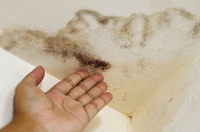Mold More Than You Can Handle? Some Pointers for Controlling It
Mold spores are likely on a variety of surfaces in your home, ready to germinate. They will lie dormant for months, or even years, just waiting for the perfect amount of ambient moisture and temperature to start growing and thriving.
Why Does Mold Grow in the Winter?
In winter months, when your home is being heated, mold prefers to grow on colder, exterior walls and windows that are not well insulated. Here, humid air comes in contact with a relatively chilled surface, and the water condenses out of the air, providing the perfect environment for molds to grow. Attics are also a typical problem area, which is why keeping attic spaces closer to the home’s ambient temperature will mitigate this issue significantly.
A Significant Health Hazard
Unfortunately, mold presents a real health hazard to people living or working in an environment with humidity issues. Not only does the air smell dank and musty, but certain types of molds can cause allergic reactions, asthma, and other respiratory or pulmonary illnesses.
The water in the air can come from many different sources, such as leaky pipes or a leaking roof, flooding, having part of the house underground (such as a basement or crawlspace), or even something as simple as cooking, which creates steam.
You Can Help Prevent Mold in Your Home by:
- Vacuuming and cleaning surfaces regularly
- Repairing sources of moisture (such as a leaky roof)
- Cleaning refrigerator drip pans regularly
- Sealing the walls in underground spaces
- Ventilating problem areas (attic and crawl spaces)
- Using washable throw rugs (or converting to easy-to-clean floor surfaces) in rooms that are susceptible to moisture issues
If you find mold already growing in your home, tackle the problem quickly before your health or your home is damaged. If the problem is small, and your health is suitable for the job, follow the federal EPA’s guidelines for cleanup. Larger problems may require a contractor or other cleaning professional.
For more comfort and wellness solutions for your home, as well as expert HVAC advice, NisAir Air Conditioning & Heating can provide you with helpful answers and services. Please contact us for more information.

